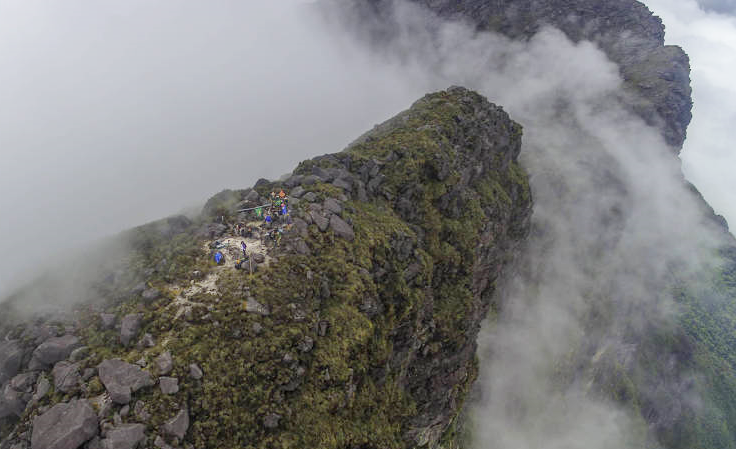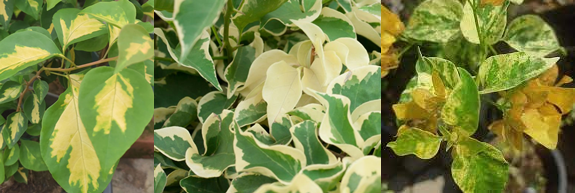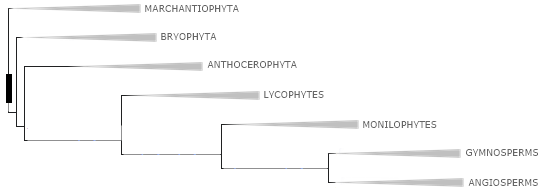Brazil have around 33,379 spp. of described angiosperms, with over 18,000 endemics, showcasing an exceptional diversity of adaptation forms in soil, freshwater, coastal environments, and upon other plants. Here, we propose to classify the country's plant diversity into 50 categories of vegetative forms, based on extensive bibliographic research.
The vast majority of Brazil's angiosperm diversity fits into ordinary terrestrial forms of (1)tree, shrub, epiphytes, lianas, and herbs. Trees range from measly 2cm to 88m meters (Dinizia excelsa), exhibiting various patterns of branch architecture, leaves, barks, flowers (many cauliflorous, some flagelliflorous), and fruits; their leaves span from afilous species to Coccobola gigantifolia, with simple leaves reaching up to 3m in width. Similar patterns are observed with shrubs and herbs. Lianas, in turn, can be flexible, like in Cucurbitaceae and Convolvulaceae, and woody, like some Fabaceae. This category also includes a significant portion of terrestrial hemiparasites, as in Krameriaceae, Orobanchaceae, and Santalales.
Some variants of shrubs stand out: the (2)branching xilopodics, with underground organs, notable examples in Brazil like Anacardium, Jacaranda, and Stryphnodendron; the ultra rare (3)non-branching xilopodics, like Sinningia helioana, where leaves grow directly from the bulb; (4)caudiciforms, deriving from herbs but creating a woody base, like some Bulbostylis and many Cryptanthoids; (5)hyper-thorny, sometimes leafy, with extreme forms like Quiabentia, Colletia, and Discaria in Rhamnaceae; (6)cushions, sparsely represented in Brazil, with notable examples in Paepalanthus; (7)non-Cactaceae succulents, in Brazil represented by Portulaca, some Peperomia and Euphorbia; rare (8)spiny succulents non-Cactaceae, like Diosocorea basiclavicaulis; (9)ephedroid, sparsely represented in Brazil but identified in Polygonum, Orthosia, and some Spigelia; (10)dracenoid, with notable examples in Brazil being Vellozia and Cordyline; (11)ground rosettes, spiny or not, well represented in Brazil by many Bromeliaceae, Furcraea, Orectanthe, and Eryngium; (12)caulirosules, with the most notable example in Brazil being Prestelia and some Microlicia; and (13)phyllocladoids, like some Phyllanthus and Brasiliopuntia.
The most notable tree variants are the forms (14)cecropioids, well represented by Cecropia, and (15)mangrove species, which migrated to the partially saline environment on the coast, with representatives of Rhizophora, Conocarpus, Laguncularia, and Halairanthus in Brazil.
Some plants, between shrub and tree size, have assumed a (16)candelabriform non-cacti aspect, with leaves at the extreme branches, as seen in some Merianthera, Jatropha, some Caricaceae, Hyptis, Wunderlichia and Mimosa.
Among herbs, they can be as tiny as Lepuropetalum at 2cm in diameter to giants like Phenakospermum. Some creep in environments forming carpets, the (17)carpet-forming, like Raddiella, Micranthemum, Callisia, Elatine, and some Euphorbia and Pilea, some Convulvulaceae, Rubiaceae and Lycianthes. Others, in pre-marine environments, have assumed the (18)salicornioid habit, like Sarcocornia and Batis. Still near the sea, some have taken the (19)sesuvioid habit, like Sesuvium, Ammania, Rotala, Laurembergia, and some Gomphrena. Two other interesting categories of herbs are the (20)graminids, typical of Monocots like Tofieldiaceae, Juncaginaceae, Velloziaceae, Cyclanthaceae, Nartherciaceae, Typhaceae, Rapateaceae, Thurniaceae, Juncaceae, Cyperaceae, Poaceae, Eriocaulaceae, Xyridaceae, Commelinaceae, and Haemodoraceae; the (21)juncoid aphyllous, as seen in Glaziophyton mirabile; and the (22)bulb-bearing, like Amaryllidaceae, Asparagaceae, Orchidaceae, Iridaceae, and at least a single Pitcairnia.
(23)Giant herbs may include members of Araceae, Taccaceae, Orchidaceae, Worsleya, Eriocaulaceae, Heliconiaceae, Strelitziaceae, Maranthaceae, Cannaceae, Zingiberaceae, Costaceae, Gunneraceae, Alstroemeriaceae, and Caricaceae; whereas (24)sacciform-leaved herbs only include Saccifolium bandeirae from Mount Neblina.
Among epiphytes/lianescent, four myriad forms stand out: (24)aerial parasites, strongly represented in Loranthaceae and Santalaceae; (25)hoyoids, growing adherent to the substrate, where in Brazil some Peperomia, Constantia, Monstera, Acianthera, Marcgravia, and Codonanthe can be mentioned; (26)pendulous, like some Rhipsalidae, Dichaea and Isochilus; (27)electric-grid epiphytes, like Tillandsia recurvata; (28)negatively growing lithophytes, like Tillandsia reclinata; (29)cacti-epiphyllous, like Hatiora and many Rhipsalis; (30)strangulating, like some Ficus and Spirotheca; and (31)tank epiphytes, like many Bromeliaceae.
Some notable types include plants that encompass more than one major group, like the (32)bambusoids, which include herbaceous forms (in Orchidaceae and Marantaceae) and woody forms (like true bamboos), the (33)palmoids, including shrub-like forms like Cyclanthaceae and many Arecaceae, and tree-like forms, like most Arecaceae; and the (34)odd leaf forms forms, as ericoid, passerine, microphyllous, quandrangular or worled leaves at the stem, widely present in Brazilian savannas, found in members of Myrcia, Spermacoceae, Declueuxia, Mandevilla, Sauvagesia, Ruehssia, Minaria, Hyptis, Lychnophorinae, Lucilia, Baccharis, Agrianthus, Catolesia, Hypericum, Heteropterys, Turnera, some Linum, Moninna, Senega, Chamaecrista, Cuphea, Cambessedesia, Microlicia, Marcetia, Microtea, Caryophyllaceae, Xerosiphon, Froelichiella, Ledothamnus, Declieuxia, Deianira, Calolisianthus, and Barjonia.
All the above plants are essentially terrestrial and amphibious. Many forms are aquatic, notably the (35)floating, like Nympheaceae, Lemnoideae, Pistia, Alismataceae, Phyllanthus fluitans, Ludwigia sedoides, and Nymphoides; the (36)submerged/aerial, like Cabombaceae, freshwater Hydrocharitaceae, Potamogetonaceae, Mayacaceae, Eriocaulaceae, Pontederiaceae, Ceratophyllaceae, Ranunculus, Myriophyllum, Podostemaceae, Callitriche, Anamaria and Lilaeopsis; and the (37)sea grasses, in Hydrocharithaceae, Ruppiaceae, and Cymodoceaceae.
Cactaceae, with the exception of Pereskioideae, some forms in Opuntioideae, and epiphytic cacti, stand as separate types: (38)opuntioid, like Tacinga; (39)microglobular, like Frailea; (40)common cactoid, thin or thick, like Cereus and Facheroa; (41)macroglobular, like some Parodia, Melocactus, and Uebelmania; (42)branching, with very thin branches, like Harrisia and Arrojadoa; and (43)massive-diffuse, like some forms of Gymnocalycium.
Four carnivorous forms deserve mention as well: the (44)pitchers, like Heliamphora; the (45)droseroids, like Drosera; the (45)round subterranean-leaves, as in Philcoxia; and the (47)Lentibulariaceae, in the case of Utricularia and Genlisea.
All the above plants are photosynthetic. There are three types of non-photosynthetic: the (48)achlorophyllous terrestrials, like Prosopanche, many Burmaniaceae, Thismiaceae, Triuridaceae, Orchidaceae, Balanophoraceae, Voyria and Voyriella; the (49)aerial lianas, like Cassytha and Cuscuta; and the (50)isophasics, like Apodanthaceae.
May 08, 2024
ANGIOSPERMS OF BRAZIL: A HABIT SYNOPSIS✅
April 29, 2024
CASIQUIARE CHANNEL
The Casiquiare river is a distributary of 326 km of the upper Orinoco flowing southward into the Rio Negro, entirely in Venezuela, South America. As such, it forms a unique natural canal between the Orinoco and Amazon river systems. It is the world's largest river of the kind that links two major river systems, a so-called bifurcation. The area forms a water divide, more dramatically at regional flood stage (W). For more informations, see Laraque, A. et al. (PRE-PRINT, 2019).
The origin of the Casiquiare, at the River Orinoco, is 14 km below the mission of La Esmeralda at 3°8′18.5″N 65°52′42.5″W, and about 123 m above sea level. Its mouth at the Rio Negro, an affluent of the Amazon River, is near the town of San Carlos and is 91 metres above sea level (W)
April 28, 2024
What is the plant that grows tallest in Brazil
An interesting question that can be asked about Brazilian biodiversity is: what is the plant that grows tallest in Brazil? The answer is simple: the plants that grow at the top of Mount Neblina. Since Brazil's maximum altitude is only 2,995m, the mountaintop is still in a zone fully occupied by angiosperms. Part of the answer can be deduced with a photo of the extreme top, where it is possible to see the immediate vegetation formation, and presume which of these plants could be mentioned. Let's deduce some possibilities, in three photos obtained from the Internet, which portray the mountaintop.
A. in this photo, it is possible to infer that the angiosperms in Brazil that grow at higher altitudes are low, herbaceous plants that do not even reach the size of a shrub. There's not much more to say.
B. in this photo, it is possible to see small rosettes, which suggest they are members of Poales, possibly Bromeliaceae, Cyperaceae, or Xyridaceae, with a low probability of being Poaceae.
C. this third photo reinforces the possibility that the highest altitude plants in Brazil are Bromeliaceae.
Most likely, the plants that grow at the highest altitudes in Brazil are Cyperaceae or Bromeliaceae.
February 25, 2024
RUSHMORE BRASILEIRO

|
| EM ORDEM: MANUEL PRETO (?-1630), RAPOSO TAVARES (1598-1659), FERNÃO DIAS (1608-1681), MANUEL BORBA GATO (1649-1718), DOMINGOS JORGE VELHO (1641-1709) E ANHANGUERA (1672-1740) |
February 07, 2024
January 18, 2024
PORTUGAL: THE 27th BRAZILIAN STATE

|
| 1nd AND 2nd LARGEST SOURCE OF IMMIGRANTS TO PORTUGAL BY DISTRICT IN 2018 (REDDIT). |
January 17, 2024
BOUGAINVILLEA: THE BRAZILIAN QUEENS
January 15, 2024
FUNGI REALM
Armillaria ‣ Armillaria species at Physalacriaceae (12 spp.), absents in South America.Mycenoid ‣ 4-8 genera with bioluminescents, Mycena, Filoboletus (manipularis group), Panellus (Panellus/Dictyopanus species), Roridomyces, and Resinomycena (a single bioluminescent, exclusive from SE Brazil), all anchored in the family Mycenaceae. 17 luminescent species in Brazil (Soares, C.B. et al, Phytotaxa, 2024), three in Amazonia Complex.Omphalotus ‣ (4/)12 bioluminescent spp. (Wikipedia), Neonothopanus (2) and Omphalotus (10, California to Texas and NW & N Mexico, E U.S.A., SW South Africa, S China to Japan in E Asia, S Australia to Tasmania) plus Nothopanus eugrammus (Japan to Malaysia) and Pleurotus decipiens, only the former in N & NE Brazil (Neonothopanus gardneri), mainly in palms.Lucentipes ‣ two species: Gerronema viridilucens, described in 2005 based on material collected from the bark of living Eugenia fluminensis O.Berg. trees in S São Paulo State in SE Brazil; and Mycena lucentipes Desjardin, Capelari & Stevani, knwoon from SE Brazil and Puerto Rico (Desjardin et al., Mycologia, 2005); both form an independent lineage of bioluminescent fungi with uncertain phylogenetic position at the family level.
Eoscyphella ‣ a single species, exclusive from Brazil, Eoscyphella luciurceolata Silva-Filho, Stevani & Desjardin, known from a bark of Solanum swartzianum in the Atlantic Rainforest, southern Brazil. Known only from the type locality (Silva-Filho et al., Journal of Fungi, 2023).
August 22, 2023
BRICS, 2023

Dada a importância geopolítica e econômica desse conjunto de nações emergentes, diversos países manifestaram interesse em se unir ao BRICS (Rússia, China, Brasil, Índia, África do Sul) ao longo do tempo. Contudo, há a carência de uma única fonte que ofereça uma lista completa de aspirantes a membros em língua portuguesa, resultando em informações fragmentadas. Nesse contexto, listamos aqui as nações que expressaram interesse em aderir ao BRICS, em meados da cúpula de 22 de agosto de 2022, na África do Sul.
CANDIDATOS COM SOLITAÇÃO FORMALIZADA: Arábia Saudita, Argélia, Argentina, Bangladesh, Bahrein, Belarus, Bolívia, Cazaquistão, Cuba, Egito, Emirados Árabes Unidos, Etiópia, Guiné Equatorial, Honduras, Indonésia, Irã, Kuwait, Marrocos, Nigéria, Senegal, Tailândia, Venezuela, Vietnã (Exame), Comores, Gabão, Guiné-Bissau, R.D. Congo, Zimbabue e Kuwait (Poder 360).
Por outro lado, o Banco dos Brics já conta com oito associados, incluindo Bangladesh, Emirados Árabes e Egito, que entraram na instituição de desenvolvimento em 2021. O Uruguai deve entrar logo (O Globo).
Como as moedas de todos os países do Brics começam com a letra R, uma eventual moeda única poderia se chamar 5R, arriscou uma fonte envolvida nas discussões: o Brasil tem o real; a Rússia, o rublo; a China, o remimbi; a Índia, a rúpia; e a África do Sul, o rand. Essa proposta está apenas em estudo, é de difícil implementação e, no melhor cenário, só entraria em vigor após 2025 (O Globo).
August 19, 2023
NEW SCENARY FOR BRAZILIAN FLORA ✅
LAST UPDATED IN 30.09.2024
Fagaceae (2/2), Betulaceae (1/1), Juglandaceae (3/3), Myricaceae (1/5), Collumeliaceae (2/2), Dipentodontaceae (1/7), Tapisciaceae (1/3), Polemoniaceae (2/3), Montiaceae (2/5), Actinidiaceae (1/34), Grossulariaceae (1/9), Dipterocarpaceae (1/1), Cytinaceae (1/1), Hydrangeaceae (1/3), Phyllonomaceae (1/1), Papaveraceae (1/2), Nelumbonaceae (1/1), Hamamelidaceae (1/1), Mitrastemonaceae (1/1), Alzateaceae (1/1), Namaceae (1/1), Phrymaceae (2/2), Peltantheracae (1/1), Cornaceae (1/1), Tovariaceae (1/1), Coriariaceae (1/1), and Tetrachondraceae (1/1).
Tetrachondraceae, with only Polypremum procumbens, apparently known from a single collection. Mitrastemonaceae is known in Colombia from a single locality.
¹Tovariaceae (1/1), Phyllonomaceae (1/1), Coriariaceae (1/1), Nelumbonaceae (1/1), Cytinaceae (1/3), Mitrastemonaceae (1/1), Actinidiaceae (1/21), Hydrangeaceae (6/36), Tapisciaceae (1/1), Dipentodontaceae (1/2), Melanthiaceae (4/36), Grossulariaceae (1/23), Juglandaceae (4/14), Saxifragaceae (4/20), Fagaceae (2/138), Betulaceae (4/6), Polemoniaceae (22/105), Cornaceae (1/4), Koeberliniaceae (1/1), Tetrachondraceae (1/1), Zosteraceae (2/3), Hamamelidaceae (3/3), Frankeniaceae (1/5), Papaveraceae (10/44), Phrymaceae (7/48), Myricaceae (1/3), Montiaceae (5/27), Anacampserotaceae (1/1) and Namaceae (4/46).
²Balsaminaceae (1/1), Nyssaceae (1/1), Setchellanthaceae (1/1), Sarcobataceae (1/1), Fouquieriaceae (1/11), Simmondisiaceae (1/1), Crossossomataceae (3/5), Stegnospermataceae (1/3), Guamatelaceae (1/1), Petenaeaceae (1/1), Plocospermataceae (1/1), Ticodendraceae (1/1), Resedaceae (2/10), Datiscaceae (1/1), Paeoniaceae (1/1), Saururaceae (2/2), Platanaceae (1/5), Schisandraceae (2/2), Liliaceae (4/26), Garryaceae (1/9), Altingiaceae (1/1, Liquidambar) and Iteaceae (1/3, Pterostemon).
Nyctaginaceae: Reichenbachiaceae.
Solanaceae: Duckeodendronaceae, Schizanthaceae and Goetzeaceae.Celastraceae: Parnassiaceae.Primulaceae: Theophrastaceae, Samolaceae and Myrsinaceae.Santalaceae: Amphorogynaceae, Cervanthesiaceae, Comandraceae, Nanodeaceae, Thesiaceae and Viscaceae.Asparagaceae: Agavaceae, Anthericaceae, Herreriaceae, Hyacinthaceae, Laxmaniaceae, Themidaceae and Ruscaceae.
Specifically the fragmentation of Asparagaceae s.l. and taking into account only Brazil, Mexico and Colombia: Themidaceae, Asparagaceae s.s. and Ruscaceae occur only in Mexico; Hyacinthaceae, Herreriaceae and Laxmanniaceae occur only in Brazil; Anthericaceae and Agavaceae occur in all three countries.
Fagaceae (2/2), Betulaceae (1/1), Juglandaceae (3/3), Myricaceae (1/5), Collumeliaceae (2/2), Dipentodontaceae (1/7), Tapisciaceae (1/3), Polemoniaceae (2/3), Montiaceae (2/5), Actinidiaceae (1/34), Grossulariaceae (1/9), Dipterocarpaceae (1/1), Cytinaceae (1/1), Hydrangeaceae (1/3), Phyllonomaceae (1/1), Papaveraceae (1/2), Nelumbonaceae (1/1), Hamamelidaceae (1/1), Mitrastemonaceae (1/1), Alzateaceae (1/1), Namaceae (1/1), Phrymaceae (2/2), Peltantheracae (1/1), Cornaceae (1/1), Tovariaceae (1/1), Coriariaceae (1/1) and Tetrachondraceae (1/1).
¹Primulaceae (2/7, Androsace, Primula), Tovariaceae (1/1), Phyllonomaceae (1/1), Coriariaceae (1/1), Nelumbonaceae (1/1), Cytinaceae (1/3), Mitrastemonaceae (1/1), Actinidiaceae (1/21), Hydrangeaceae (6/36), Tapisciaceae (1/1), Dipentodontaceae (1/2), Melanthiaceae (4/36), Grossulariaceae (1/23), Juglandaceae (4/14), Saxifragaceae (4/20), Fagaceae (2/138), Betulaceae (4/6), Polemoniaceae (22/105), Cornaceae (1/4), Koeberliniaceae (1/1), Tetrachondraceae (1/1), Zosteraceae (2/3), Hamamelidaceae (3/3), Frankeniaceae (1/5), Papaveraceae (10/44), Phrymaceae (7/48), Myricaceae (1/3), Montiaceae (5/27), Anacampserotaceae (1/1) and Namaceae (4/46).
²Asparagaceae (1/5), Balsaminaceae (1/1), Comandraceae (1/1, Comandra), Themidaceae (), Ruscaceae (), Nyssaceae (1/1), Setchellanthaceae (1/1), Sarcobataceae (1/1), Fouquieriaceae (1/11), Simmondisiaceae (1/1), Crossossomataceae (3/5), Stegnospermataceae (1/3), Guamatelaceae (1/1), Petenaeaceae (1/1), Plocospermataceae (1/1), Ticodendraceae (1/1), Resedaceae (2/10), Datiscaceae (1/1), Paeoniaceae (1/1), Saururaceae (2/2), Platanaceae (1/5), Schisandraceae (2/2), Liliaceae (4/26), Garryaceae (1/9), Altingiaceae (1/1, Liquidambar) and Iteaceae (1/3, Pterostemon).
Includes Uruguayan families absent in Brazil: Papaveraceae and Polemoniaceae. Montiaceae and Frankeniaceae are unlikely.
Dipterocarpaceae occurs very close to the border of Brazil, in an environment similar to downstream of large rivers. Most likely to occur in Brazil.
Koeberliniaceae, Corsiaceae, Tapisciaceae, Dipentodontaceae, Montiaceae, Phyllonomaceae and Actinidiaceae are families with non-zero probability of occurring in Brazil.
July 19, 2023
IDH DO MUNDO, JUL 2023
ARTIGO ORIGINAL: https://www.ihu.unisinos.br/categorias/630550
O Índice de Desenvolvimento Humano (IDH) é um indicador estatístico composto por 3 componentes: saúde, educação e renda, por meio da expectativa de vida, da média de anos de escolaridade completados e anos esperados de escolaridade ao entrar no sistema educacional e indicadores de renda per capita. O IDH é um dos melhores índices disponíveis para se avaliar o desenvolvimento humano dos países.
 |
| IDH TOP 25 + BRICS; 2020, 2021 | EcoDebate |
De modo geral, o IDH tem crescido nas últimas décadas. O Índice de Desenvolvimento Humano para o mundo cresceu cerca de 0,05 entre a última década do século XX e a primeira década do século XXI, atingindo 0,645 no ano 2000. Na década passada o IDH global passou de 0,697 em 2010 para 0,732 em 2021, o menor ritmo de avanço desde a criação do indicador. A tabela abaixo mostra os 25 países com maior IDH em 2000 e 2021 e também os dados para os 5 países do grupo BRICS. Houve avanços em todos os países, mas em ritmos diferenciados.
O líder do ranking no ano 2000 era a Noruega e o líder em 2021 foi a Suíça, com a Noruega caindo para o segundo lugar. Os Estados Unidos da América (EUA) tinham um IDH de 0,891 em 2000, ocupando o sexto lugar no ranking, passou para um IDH de 0,921 em 2021, mas despencou para o 21º lugar. Outros países que caíram no ranking (embora tenham elevado o IDH) foram Holanda, Canadá, Bélgica, Japão, Áustria e Israel. Os países que tiveram os maiores avanços foram a Suíça, Islândia, Hong Kong, Singapura, Coreia do Sul, Malta e Eslovênia (estes dois últimos países nem estavam entre os 25 países com maior IDH em 2000). Já a França e a Itália saíram da lista dos 25 países com maior IDH entre 2000 e 2021.
Entre os países do grupo BRICS, a Rússia tem o maior IDH, sendo 0,822 em 2021, pertencente ao grupo de muito alto Desenvolvimento Humano. O Brasil vinha em seguida no ano 2000, mas nas últimas 2 décadas foi ultrapassado pela China. A África do Sul tem o quarto IDH dos BRICS e a Índia o quinto. O IDH do mundo cresceu 13,5% entre os anos 2000 e 2001. Praticamente, todos os 25 países do topo do ranking cresceram menos do que a média global, pois já estão próximos do limite máximo que é 1,000 (um). Entre os BRICS, a Rússia, o Brasil e a África do Sul tiveram variação do IDH abaixo da média global. A China teve o maior avanço percentual, com aumento de 31,5% entre 2000 e 2021 e a Índia teve aumento de 28,9% no período, embora tenha o menor nível do IDH dos 5 países do grupo BRICS.
O IDH do mundo cresceu bastante nas últimas décadas, mas às custas de uma ampla degradação ambiental. Hoje em dia a humanidade já superou a capacidade de carga do Planeta e a população mundial já está pagando o preço da crise climática e ecológica. Como mostrei no artigo “O mundo vive o risco de uma década perdida no desenvolvimento humano” (Alves, 27/01/2023), a atual década traz o desafio de retomada do desenvolvimento humano com sustentabilidade ambiental.
O Brasil que é o 5º maior território, o 7º país mais populoso e está entre as 10 maiores economias do mundo, em tamanho do PIB, mas estava em 81º lugar no ranking do IDH no ano 2000 e caiu para 87º lugar em 2021. Existem 66 países com IDH acima de 0,800 e 50 países com IDH entre 0,700 e 0,799. O Brasil está neste segundo grupo e parece que dificilmente conseguirá dar o salto para o grupo do topo do ranking (onde estão Chile, Argentina e Uruguai). O Brasil corre o risco de ficar preso na armadilha da renda média. No período de 2010 a 2021 o IDH do mundo cresceu 0,45% ao ano e o Brasil cresceu 0,38% ao ano. O Brasil terá que acelerar o passo se quiser seguir o ritmo médio de avanço do desenvolvimento humano global.
E todos os países terão que reduzir as desigualdades sociais e diminuir a sobrecarga da Terra, para evitar o consumo conspícuo e a degradação ambiental. Como disse Rita Lee: “Não quero luxo nem lixo”.
June 28, 2023
TERRESTRIAL PLANTS IN SOUTH AMERICA✅
LAST UPDATED IN 29.09.2024
⋵: 'ENDEMICS'
The Embryophyta, or land plants, are the most familiar group of green plants that comprise vegetation on Earth. Embryophytes have a common ancestor with green algae, having emerged within the Phragmoplastophyta clade of green algae as sister of the Zygnematophyceae. Living embryophytes therefore include hornworts, liverworts, mosses, lycophytes, ferns, gymnosperms and flowering plants. The tree below is one of the most consensual about the evolution of the group (Wikipedia). Bryophyta s.l. are a proposed taxonomic division containing three groups of non-vascular land plants (embryophytes): the liverworts, hornworts and mosses.
The most complete data from bryophytes in Neotropics is Hallingbäck and Nick Hodgetts (Mosses, Liverworts, and Hornworts, 2000), assignated here as [1]; some data also in Delgadillo (Bol. Soc. Bot. Mexico, 2000).
In summary, Colombia has advantage of 5 spp. against Brazil in Marchantiophyta (no advantage in genera), 65 spp. in Bryophyta (no advantagem in genera), and none advantages in Anthocerophyta. Mexico no has advantages against Brazil in Marchantiophyta and Anthocerophyta, and an advantage of 4 families, 57 genera and 114 spp. in Bryophyta.
MARCHANTIOPHYTA
Liverworts has (87:386/)7,273 spp. worldwide, by Lars Söderström et al. (PhytoKeys, 2016).
Colombia has (37:134/)703 spp. (37 endemics; CTLC, BOOK, 2016); Brazil has (39:132/)698 spp. (Reflora, 2023; 143 endemics). Brazil has 3 families absents in Colombia (Chonecoleaceae, Oxymitraceae, Sphaerocarpaceae); Colombia has one family absent in Brazil: Pseudolepicoleaceae (3/3 in country). Mexico includes (122:)592 spp. [1] and varieties in this class (Delgadillo-Moya, Botanical Sciences, 2022).
By [1], endemic genera occur in northern Andes (7), Amazonia (5), Guianan Highlands (4), SE Brazil (2, Pluvianthus, Vittalianthus), and Chocó (1); Geocalycaceae is placed under Lophocoleaceae in CPLC, and Solenostomataceae under Jungermanniaceae.
BRYOPHYTA
Mosses has c. 12,000 spp. worldwide (Wikipedia). Colombia has (65:261/)932 spp. (52 endemics; CTLC, BOOK, 2016). Brazil has (71:268/)867 spp. (209 endemics; largest diveristy of genera, 8 endemics, Costa, D.P. et al., The New York Botanical Garden Press, 2023). Mexico has (75:325/)984 spp. (Delgadillo-Moya, Rev. Mex. Biodiv. vol.85, 2014).
By [1], endemic genera occur in central Andes (12), Mexico (7), SE Brazil (5, Cladostomum, Crumuscus, Itatiella, Moseniella, Paranapiacabaea), northern Andes (4), Caribbean (3), Central America (2), Amazonia (2), and Guianas Highlands (2).
ANTHOCEROPHYTA
Hornworts has (5:12/)213 spp. worldwide, by Lars Söderström et al. (PhytoKeys, 2016).
Anthocerotaceae (2/78)
Anthoceros L. (60).
Folioceros D.C.Bharadwaj (18)
Dendrocerotaceae (4/70)
Dendroceros Nees (41)
Megaceros Campb. (11)
Nothoceros (R.M.Schust.) J.Haseg (10)
Phaeomegaceros R.J.Duff (8)
Phymatocerotaceae (1/2)
Phymatoceros Stotler (2)
Notothyladoideae (1/22)
Notothylas Sull. ex A.Gray (22)
Phaeocerotoideae (3/40)
Mesoceros Piippo (2)
Paraphymatoceros Hässel (4)
Phaeoceros Prosk. (34)
Leiosporocerotaceae (1/1)
Leiosporoceros Hässel (1)
Gradstein (Caldasia, 2018) cites (4:7/)15 spp. in Colombia. Brazil has (4:7/)18 spp. (Reflora, 2023, 3 endemics). Notothyladaceae has identical genera in both countries. Dendrocerotaceae has a genus in Colombia absent in Brazil (Phaeomegaceros R.J.Duff); Brazil has one genus in Anthocerotaceae absent in Colombia (Folioceros DC); and both countries has a exclusive family againt the other: Phymatocerotaceae (Phymatoceros Stotler, W.T. Doyle & Crand.-Stotl.) in Brazil, and Leiosporoceroaceae (Leiospoceros Hässel) in Colombia. Mexico has (3:3/)9 spp. in this class, among Anthoceros, Nothoceros and Phaeoceros, plus at least 7 undescribeds (Delgadillo-Moya, Botanical Sciences, 2022), 3 endemics.
June 27, 2023
LYCOPHYTES OF SOUTH AMERICA ✅
LAST UPDATED IN 16.02.2024
⋵: 'ENDEMICS'
Lycophyta are a group of vascular plants, one of the oldest lineages of extant vascular plants; the group contains extinct plants that have been dated from the Silurian (ca. 425 M years ago); also were some of the dominating plant species of the Carboniferous period, and included the tree-like Lepidodendrales, some of which grew over 40m in height, although extant lycophytes are relatively small plants (Wikipedia). Via Home et al. (Freie University, Berlin), Lycophytes and Monilophytes are sucessive sisters of Gymnosperms and Angiosperms.
All data below follows the World Ferns website (SEE).
ISOETALES
A single family in this order, Isoetaceae, and a single genus, Isoetes L., with 204 spp., subcosmopolitan. 37 in U.S.A., 32 in Brazil (24⋵), 12 in Colombia and 8 in Mexico.
LYCOPODIALES
A single family, Lycopodiaceae (17/)492 spp. Largest diversities in New World are Colombia (8/94, 75 only in Phlegmariurus), Brazil (9/62), U.S.A. (8/23, 1/3 in Huperzia) and Mexico (6/23, 17 in Phlegmariurus).
Brazil leads Mexico in all mexican genera except tied status in Lycopodium (1 ✕ 1) and lose in Huperzia (2 ✕ 1). Brazil leads Colombia in all colombian genera except tied status in Lycopodiella (4 ✕ 4), Austrolycopodium (1 ✕ 1), Diphasium (1 ✕ 1), Lycopodium (1 ✕ 1) and lose in Palhinhaea (8 ✕ 6) and Phlegmariurus (75 ✕ 39).
SUBFAMILY LYCOPODIELLOOIDEAE (5/57)
Brownseya (Kunze) Li Bing Zhang, L.D.Sheph., D.K.Chen, X.M.Zhou & H.He (1, Australia, Papuasia, New Zealand, New Caledonia).
Lateristachys Holub. (3, Philippines, Australia, New Zealand).
Lycopodiella Holub. 12 spp., holarctic and tropical America, six in U.S.A., 4 in Colombia and 4 in Brazil, none in Mexico.
Palhinhaea Franco & Vasconcellos. 25 spp., pantropical, 8 in Colombia, six in Brazil, only one in Mexico and U.S.A.
Pseudolycopodiella Holub. 16 spp., widely scattered worldwide, 7 in Brazil, 3 in Colombia, two in U.S.A., only one in Mexico.
SUBFAMILY LYCOPODIOIDEAE (9/45)
Austrolycopodium Holub. 7 spp., temperate southern hemisphere, mostly circumantarctic, one to tropical Africa, Brazil and Colombia one each.
Dendrolycopodium Haines. 5 spp., North America (3 in U.S.A.) and E Asia.
Diphasiastrum Holub. 17 spp., temperate northern hemisphere (5 in U.S.A.), one in South Africa and Madagascar, two to tropical America: D. thyoides (Humb. & Bonpl. ex Willd.) Holub widely from Mexico to Uruguay, except Chile and Caribbean, and D. falcatum B.Øllg. & P.G.Windisch endemic to SE Brazil
Diphasium Presl ex Rothmaler. 4 spp., D. jussiaei (Desv. ex Poir.) Rothm. in Costa Rica to Bolivia and Brazil, D. gayanum (J.Rémy) Holub in Chile and Argentina, D. lawessonianum (B.Øllg.) B.Øllg. endemic to Ecuador, and D. cariosum (G.Forst.) Rothm. from Philippines and Borneo to New Zealand.
Lycopodiastrum Holub ex Dixit. (1, Asia).
Lycopodium L. 7 spp., mainly temperate and subarctic regions, three in New World, one continentaly confined to Canada and U.S.A., L. cernua L. widely in almost all New World, and L. vestitum Desv. ex Poir. from Peru and Ecuador, possibly in Venezuela.
Pseudodiphasium Holub. (1, Asia, Australia, New Zealand).
Pseudolycopodium Holub. (1, Australia, New Zealand, New Caledonia).
Spinulum Haines. Two spp., S. lioui Li Bing Zhang & H.He (Russian Far East, China, Mongolia; North Korea; South Korea; Japan) and S. annotinum (L.) A.Haines (over Europe, Caucasus, Turkyie, Kazakhstan, Alaska to S U.S.A.).
SUBFAMILY HUPERZIOIDEAE (3/370)
Huperzia Bernhardi. 62 spp., 7 in U.S.A., two in Mexico, one in Brazil (endemic), none in Colombia.
Phlegmariurus Holub. 307 spp., worldwide pantropical. 75 in Colombia, 39 in Brazil, 17 in Mexico and only one in U.S.A.
Phylloglossum Kunze. (1, Australia and New Zealand).
SELAGINELLALES
A single family, Selaginellaceae (19/)770 spp., nine genera in New World. U.S.A includes 7 genera (one endemic; Lepidoselaginella, Valdespinoa and Selaginoides absents in Brazil), Mexico six (Didiclis and Lepidoselaginella absents in Brazil), Colombia six (Didiclis absent in Brazil) and Brazil includes only five (Gymnogynum, Bryodesma, Megaloselaginella, Pulviniella and Selaginella).
Largest diversities: Colombia (6/97), Brazil (5/81), U.S.A. (7/36) and Mexico (6/80).
Brazil and Colombia tied in Bryodesma, Megalosellaginella and Pulviniella. Brazil lose for Mexico in Bryodesma (21 ✕ 2) and Pulviniella (2 ✕ 1). Brazil lose for Colombia in Gymnogynum (24 ✕ 16) and Selaginella (67 ✕ 60).
SELAGINELLOIDEAE
Selaginoides Ség. Two sp., S. spinulosa (A.Braun ex Döll) Li Bing Zhang & X.M.Zhou from Artic to Nevada, Colorado, Maine, Mediterranean, Caucasus and souther Russia, also in Japan, and S. deflexa (Brack.) Li Bing Zhang & X.M.Zhou endemic to Hawaii.BOREOSELAGINELLOIDAE
Boreoselaginella (6, E Asia to Russia).
GYMNOGYNOIDEAE
Afroselaginella (4, endemic to Africa).
Megaloselaginella Li Bing Zhang & X.M.Zhou. Three spp., two from Costa Rica to N Brazil (one a venezuelan endemic, Colombia and Brazil one each), one in Equatorial Guinea and Gabon.
Gymnogynum P.Beauv. 48 spp., mostly tropical America, 1 tropical Africa, 1 in Asia; 24 in Colombia, 16 in Brazil and 7 in Mexico.
Ericetorum (8, Africa, Madagascar and Australia).
Lepidoselaginella Li Bing Zhang & X.M.Zhou. Three spp. from Mexico, L. lepidophylla (Hook. & Grev.) Li Bing Zhang & X.M.Zhou up to SW U.S.A. in north and Costa Rica in south.
Bryodesma Soják. 56 spp., almost cosmopolitan, mostly in temperate areas, many in U.S.A. (27) and Mexico (21). Colombia and Brazil two each.SINOSELAGINELLOIDEAE (absent in New World)
Austroselaginella (4, endemic to Australia).
Korallia (15, Madagascar and adjacent islands).
Sinoselaginella (5, China extending to the Arabic area and E Africa).
PULVINELLIOIDEAE
Pulviniella (Li Bing Zhang & X.M.Zhou) Li Bing Zhang & X.M.Zhou. 17 spp., scattered almost cosmopolitan, several in China, 3 in New World: P. convoluta (Arn.) Li Bing Zhang & X.M. Zhou (Mexico to Brazil, Paraguay and Caribbean), P. gypsophila ((A.R.Sm. & T. Reeves) Li Bing Zhang & X.M. Zhou, Mexico) and P. pilifera ((A. Braun) Li Bing Zhang & X.M. Zhou, SW U.S.A. to NW Mexico).
LYCOPODIOIDOIDEAE (South American absent in Brazil)
Hypopterygiopsis (170, Asia and Pacific islands and a few in Africa and Madagascar).
Didiclis P.Beauv. 70 spp., Africa, Asia, and Australasia, only one in New World, D. hoffmannii (Hieron.) Li Bing Zhang & X.M. Zhou, from Mexico do Ecuador.
Lycopodioides (12, Eurasia).
Valdespinoa Li Bing Zhang & X.M.Zhou. Only one sp., endemic to NW U.S.A.SELAGINELLOIDEAE
Chuselaginella (70, Africa, Asia, Australia and southern Pacific islands).
Kungiselaginella (12, Asia).
Selaginella P.Beauv. 231 spp., New World, mostly tropical America, only very few tropical Africa. 67 in Colombia, 60 in Brazil, 45 in Mexico, and only 4 in U.S.A.













